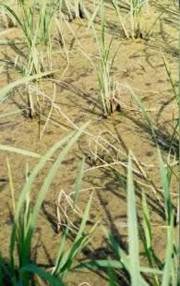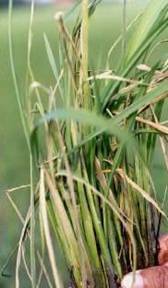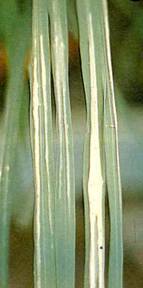


| Scientific Name : | |||||||
Xanthomonas oryzae pv. oryzae
|
|||||||
Bacterial blight is reported to have reduced Asia's annual rice production by as much as 60%. For example, in Japan, about 300,000 to 400,000 hectares of rice were affected by the disease in recent years. There were 20% to 50% yield losses reported in severely infected fields. In Indonesia, losses were higher than those reported in Japan. In India, millions of hectares were severely infected, causing yield losses from 6% to 60%.
|
|||||||
| Mode of transmission | |||||||
| Symptoms | |||||||
| Management options | |||||||
| BLB Information sheet | |||||||
Symptoms: |
|||||||
Water-soaked to yellowish stripes on leaf blades or starting at leaf tips then later increase in length and width with a wavy margin
|
|||||||
Appearance of bacterial ooze that looks like a milky or opaque dewdrop on young lesions early in the morning |
|||||||
Lesions turn yellow to white as the disease advances
|
|||||||
Severely infected leaves tend to dry quickly
|
|||||||
| Lesions later become grayish from growth of various saprophytic fungi | |||||||
Seedling wilt or kresek |
|||||||
Observed 1-3 weeks after transplanting
|
|||||||
Green water-soaked layer along the cut portion or leaf tip of leaves as early symptom |
|||||||
Leaves wilt and roll up and become grayish green to yellow
|
|||||||
Entire plant wilt completely
|
|||||||
Yellow leaf or pale yellow of mature plants
|
|||||||
Youngest leaf is uniform pale yellow or has broad yellow stripe |
|||||||
Older leaves do not show symptoms
|
|||||||
Panicles sterile and unfilled but not stunted under severe conditions
|
|||||||
| Back to top | |||||||
| Management Options : | |||||||
| Cultural | |||||||
Practicing field sanitation such as removing weed hosts, rice straws, ratoons, and volunteer seedlings is important to avoid infection caused by this disease. Likewise, maintaining shallow water in nursery beds, providing good drainage during severe flooding, plowing under rice stubble and straw following harvest are also management practices that can be followed. Proper application of fertilizer, especially nitrogen, and proper plant spacing are recommended for the management of bacterial blight.
|
|||||||
The use of resistant varieties is the most effective and the most common management practice adopted by farmers in most growing countries in Asia. When different strains of bacteria are present, it is recommended to grow resistant varieties possessing field resistant genes. Fallow field and allow to dry thoroughly is recommended.
|
|||||||
Seed treatment with bleaching powder (100µg/ml) and zinc sulfate (2%) reduce bacterial blight. Control of the disease with copper compounds, antibiotics and other chemicals has not proven highly effective.
|
|||||||
| Back to top | |||||||
